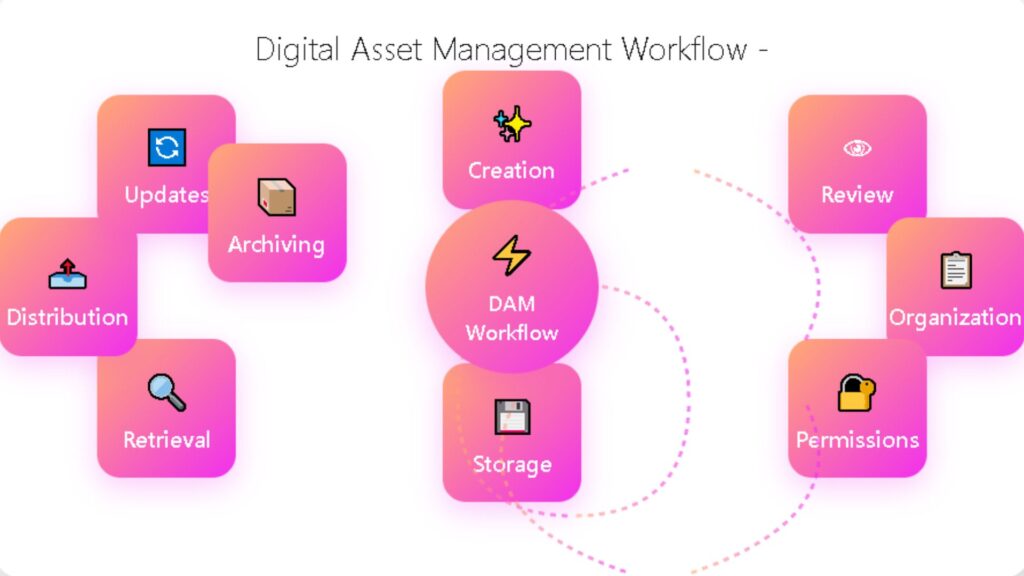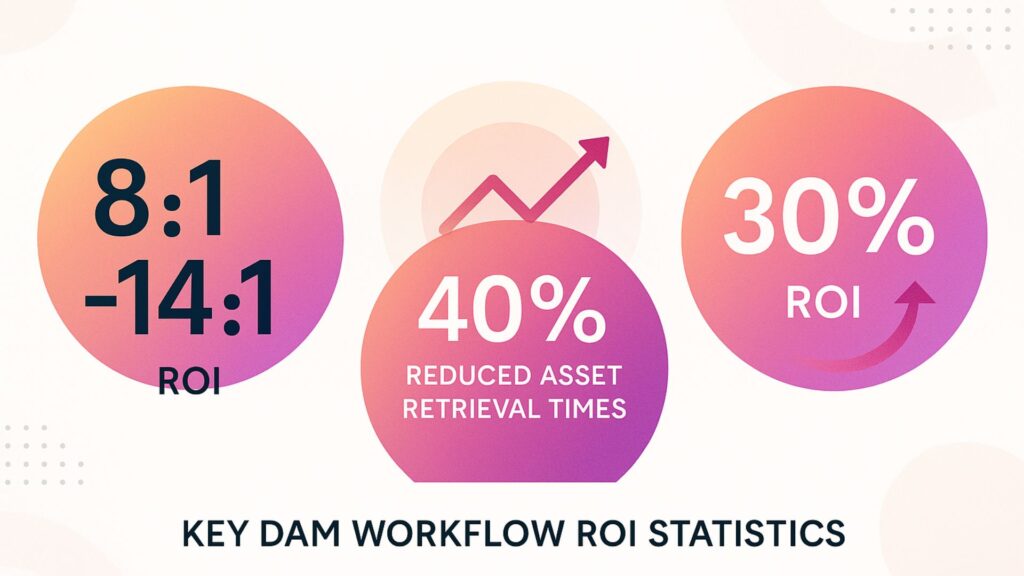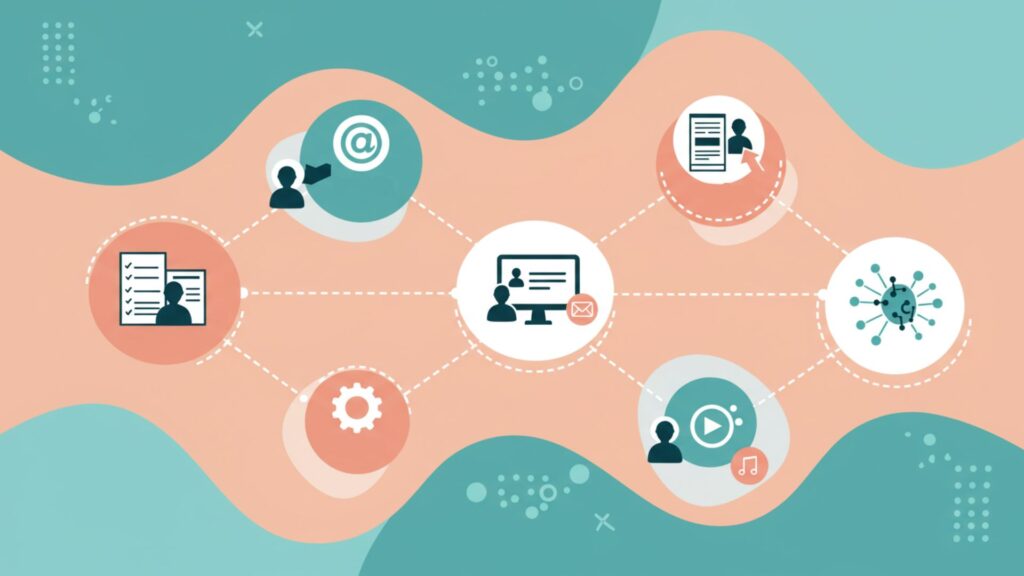Organizations implementing structured digital asset management workflows achieve significant time savings on asset-related tasks while achieving 30% ROI. Key success factors include AI-powered automation, remote collaboration capabilities, and integration with existing MarTech stacks. Recommendation: Start with core workflow automation for asset creation, review, and distribution before expanding to advanced AI features.
Whether you manage an e-commerce platform, run a digital marketing company, or operate a manufacturing business, digital assets play a key role in your success. Product images, marketing videos, downloadable whitepapers, and presentations are just a few examples of digital assets that require multiple stages of input from you and your collaborators.
With the digital asset management market growing at 17.7% annually, organizations can no longer afford scattered files and manual processes. Companies managing thousands of images, videos, documents, and multimedia files are recognizing that digital asset management workflows eliminate siloed approaches that can be so detrimental to information management and connect both internal and external users to a central source of truth.
When done right, DAM workflows facilitate efficient digital asset production, consistent branding, and real-time collaboration. Recent research shows that approximately 61% of organizations are currently leveraging DAM systems, with a reported 30% ROI from implementations.
But using DAM software is just the starting point for effective asset management. You also need to establish a well-planned workflow to optimize the way you and your team handle digital assets, from ideation to distribution. Your approach to managing the DAM process will ultimately determine how successfully you can guide digital assets through their entire lifecycle.
What Is a Digital Asset Management Workflow?
A digital asset management workflow is more than the technical processes of uploading and organizing files. A DAM workflow is your blueprint for managing all your digital assets and utilizing them to complete projects. DAM software is the collection of tools you use to build out your support, organization, and automation processes.
While some workflows can be limited to focusing on creating and distributing the digital assets themselves, other digital asset management workflows may have a much larger scope, incorporating multiple digital assets as smaller pieces of a larger campaign.
A digital asset management workflow is flexible enough to facilitate multiple approaches to asset management, even when working with the same technical DAM system. It outlines how you handle the people, processes, and digital assets that collaborate and interact with the DAM platform at any given time. Your workflow essentially becomes the roadmap that guides your entire DAM process, ensuring consistency and efficiency regardless of team size or project complexity.
Why Are Digital Asset Management Workflows Important?
DAM systems are built to track and manage a large volume of digital assets. Many different users, from designers and creative directors to administrators and end clients, may need to access the system and find their desired assets quickly. In larger organizations, this group can extend to multiple teams and departments that might need to collaborate across time zones or countries.
Remote work has highlighted the need for tools that support DAM collaboration across distributed teams. Digital assets are often scattered across various storage solutions, making it difficult for remote teams to access the files they need.
Without a clearly established workflow to dictate the best practices for managing a shared DAM system, it would be difficult to efficiently maintain the digital asset library. Digital asset management workflows make it easier for everyone involved in the asset lifecycle management process to stay connected. The right DAM process can reduce bottlenecks in the review and approval process and allow the project to run smoothly. As a result, projects involving multiple assets are completed faster and with fewer mistakes.
How AI Is Transforming Digital Asset Management Workflows
Organizations implementing AI in digital asset management are seeing significant improvements in efficiency and content discovery capabilities.
AI transforms DAM workflows in several key ways:
Automated Metadata Generation: Machine learning algorithms can analyze image content, extract text from videos, and automatically generate relevant tags and descriptions. This eliminates the manual tagging process that previously consumed hours of staff time.
Intelligent Content Recognition: AI can identify faces, objects, text, and brand elements within assets, enabling automatic categorization and compliance checking. This is particularly valuable for organizations managing large volumes of visual content.
Predictive Workflow Optimization: AI algorithms analyze historical workflow data to predict bottlenecks, suggest optimal approval paths, and recommend content repurposing opportunities based on performance metrics. This intelligence helps organizations continuously refine their DAM process for maximum efficiency.
Smart Content Creation: Generative AI tools can now create asset variations, write descriptions, and generate new content based on existing brand guidelines, accelerating the creation phase of workflows.
The market for AI in content creation is expected to reach $163.8 billion by 2033, growing at 31.20% annually. This growth is driving DAM platforms to integrate more sophisticated AI capabilities that can handle the increasing volume and complexity of digital assets.
6 Benefits of Establishing a Digital Asset Management Workflow
A customized DAM workflow developed for your team’s needs carries multiple benefits that extend to brand management, team collaboration, and organizational efficiency. Industry research demonstrates the measurable impact of structured workflows, with organizations reporting significant cost reductions and productivity improvements.
Establishing clear governance and accountability: Having a set of guidelines and steps to follow ensures that all of your digital assets receive proper approval before publication while eliminating confusion about procedures and task responsibilities. By establishing standardized workflows, project managers gain comprehensive visibility into asset locations and status levels, removing bottlenecks caused by unclear processes and speeding up project timelines.
Enhancing DAM collaboration and communication: Digital asset management workflows make it clear who is responsible for what. The overall quality of work is improved, and it reduces the time spent coordinating efforts between internal and external teams. Workflows can set specific feedback expectations so everyone knows when and where to comment during the digital asset’s lifecycle, keeping things moving and on track to meet deadlines.
Enabling intelligent process automation: You can strategically define which manual processes to automate, like creating meta tags for individual assets, organizing files, switching between file formats, or creating adaptive versions of content to suit different publishing formats and devices. Establishing a structured workflow helps you think strategically about automation impact and use it more effectively, rather than relegating too much to automated systems that might reduce quality oversight.
Encouraging you to rethink your organizational strategy: When setting up your DAM workflow, standardize naming conventions and organization practices so your team can quickly find the assets they need. You can improve overall system accessibility and help reduce the time spent coordinating with subject matter experts for minor issues.
Safeguarding your digital assets: User-based access permissions and password protection give asset managers precise controls over who can access assets throughout their various lifecycle stages. As you think through your DAM workflow, keep data security in mind when selecting who has access to your information and how they can interact with potentially sensitive assets.
What Are the 9 Stages of a Digital Asset Management Workflow?
Digital asset management workflows can be divided into stages that describe the process of an individual asset’s lifecycle from ideation to storage and publication. Understanding these stages is vital for effective asset lifecycle management and ensures your organization maximizes the value of every digital asset from creation through retirement.
1. Creation
The first stage of a DAM workflow involves creating assets, such as images or documents, through ideation, drafting, and development.
Example: Your marketing team requests a video for a new campaign. The creative team responds to this request by coming up with ideas, outlines, and drafts that need review and approval before the project can commence.
2. Review and Approval
A fresh asset must be submitted to relevant team members for review and approval. During this stage, version control helps track suggestions and changes in real time so that file owners can view a clear history of edits.
Example: Your editorial team receives the first draft of the marketing video and sends it back to the creative team with comments and suggestions for a second cut.
3. Organization
After the asset is created, it needs to be entered into the DAM system and organized for easy tracking. This stage involves creating metadata like tags, keywords, and descriptions that allow users to efficiently locate the assets in their appropriate folders and categories. Some DAM systems incorporate AI technology to help you automate the tagging and searching functions.
Example: The completed campaign video is submitted to the DAM system. The software reviews the content and assigns relevant tags and other metadata before filing the asset in the appropriate folder.
4. Permission Controls
A crucial part of organizing any asset in the DAM system involves setting appropriate access controls. You can decide exactly who can retrieve individual assets and whether they have permission to download, share, or edit the content.
Example: Your client wants to view the video to offer their feedback, but since you’re not ready to publish it, you set the asset as view-only and share a password-protected external link with them.
5. Storage
In addition to being cataloged in your DAM solution, all of the organized data needs to be stored securely in an accessible location. This often includes both cloud-based storage as well as offline servers that provide a safe backup location in case of a data breach.
Example: Your campaign video is stored on a password-protected, cloud-based server so only your clients can access the content for review and publication.
6. Retrieval
The retrieval stage describes how permissioned users access the DAM and locate specific assets by using the metadata. AI can assist with improving the search functionality within your database.
Example: Your client logs into the online DAM system and searches for your campaign video using relevant tags or keywords. They quickly find what they’re looking for and leave real-time feedback for your production team.
7. Distribution
In the distribution stage, the asset is shared with internal or external users or publishing channels. While assets can be downloaded from the DAM platform and shared manually, most DAM systems offer integrations with popular distribution channels so that brands can publish content seamlessly from the DAM platform itself.
Example: The finished campaign video is ready to be published on your client’s website. Since they’ve integrated the DAM system with their distribution channels, they upload the video directly from the DAM database.
8. Updates
Older assets may need periodic updates depending on their level of use or their timeliness to current events. The update process may require the asset to go back to the original creative team and travel through each stage all over again.
Example: The previous campaign video was a success, so your client wants to reuse the format for a newly launched product. You send the asset back to the creative team to reformulate and adapt the video for reuse.
9. Archiving
Once an asset’s lifecycle is completed, it can be archived in long-term storage for future reference or reactivation.
Example: The campaign video is retired when your client goes in a different direction for their next campaign, so it’s moved to a relevant archive folder.

6 Different Types of Digital Asset Management Workflows
You probably wouldn’t use a social media post and a whitepaper to achieve the same results. Likewise, there are different types of DAM workflows that can be customized to best suit your long-term organizational objectives or short-term campaign targets.
For example, if you want to prioritize the reviewing and editing process, you could choose the communication-enhancing structure of a collaborative workflow. If you’d rather focus on reviewing and cleaning up old files in a bloated database, you might consider setting up an archival workflow.
Take a look at the available options when selecting a DAM workflow that works for you:
1. Asset-Based Workflows
This type of workflow focuses on creating, managing, and distributing the digital assets themselves.
- Good for streamlining the asset production process
- Helps produce assets that are consistent and on point with brand guidelines
- Useful for organizations that deal with large volumes of digital assets
- Should be integrated with creative tools that aid in asset creation
2. Project-Based Workflows
Project-based workflows place more focus on the overall project than the individual assets that contribute to the project.
- Good for coordinating teams and managing a wide range of project-related tasks not necessarily related to digital assets
- The deliverable is the overall project, not an individual asset
- Useful for teams that work on complex projects involving lots of moving parts
- May involve multiple assets that can be used in the same project
3. Collaborative Workflows
This workflow prioritizes communication between team members or cross-team collaboration.
- Built around real-time communication and feedback
- Useful when many people need to be involved in the creation, editing, and publishing of shared assets
- Steps should be taken to introduce standardized procedures to avoid bottlenecks
- User-based access and permission controls should be prioritized for data security
4. Approval Workflows
Approval workflows focus on the specific process of approving drafts and asset versions before distribution or publishing.
- Useful for organizations that deal with sensitive or confidential assets that require extra scrutiny before distribution
- Good for ensuring regulatory compliance or adhering to complex brand standards and guidelines
- A single asset may be required to go through several rounds of approval before distribution
- Reduces the chance of errors making it into the final version
5. Transactional Workflows
This workflow is typically used in the sale or licensing of digital assets, such as copyrighted images, music, or videos.
- Facilitates asset distribution that reaches third parties in compliance with legal or regulatory frameworks
- Good for monetizing digital assets
- Useful for tracking asset transactions and providing data trails that can be used in financial audits
- Helps manage usage rights for digital assets
6. Archival Workflows
Archival workflows focus on managing the DAM system and ensuring that assets that are no longer in active use can be easily found and recovered as needed.
- Useful for clearing cluttered databases and freeing up active storage space
- Good for maintaining data integrity and security
- Can be used to store historical assets for future use
- May help in reducing storage costs
How Does Remote Work Impact DAM Collaboration?
The shift to distributed teams has changed how organizations approach DAM collaboration. According to research, 48% of employees struggle to find the assets they need due to confusing or disorganized digital systems. Remote work has intensified the demand for streamlined collaborative workflows.

Challenges of Remote DAM Collaboration:
Time Zone Coordination: When team members are spread across different time zones, traditional approval workflows can create significant delays. A designer in New York may finish an asset at the end of their workday, but approvers in London won’t review it until the next morning, effectively adding 16+ hours to the workflow.
Version Control Complexity: Without centralized workflows, remote teams often work on outdated versions of assets, leading to conflicting edits and rework. This problem is amplified when external agencies or freelancers are involved in the creation process.
Communication Gaps: Remote teams struggle with context that would typically be shared in person. Without clear workflow documentation, team members may not understand approval requirements, brand guidelines, or project priorities.
Solutions for Remote DAM Workflows:
Asynchronous Approval Processes: Modern DAM workflows incorporate automated notifications and parallel approval paths that keep projects moving regardless of time zones. Smart routing can automatically send assets to the next available approver when primary reviewers are offline.
Real-Time Collaboration Features: Built-in commenting, annotation tools, and version tracking ensure all feedback is captured directly within the asset workflow. Teams can see exactly what changes were requested and by whom, eliminating confusion from email chains.
Automated Status Updates: Workflow automation sends proactive notifications about project status, approaching deadlines, and required actions, keeping distributed teams aligned without manual coordination.
The most successful remote DAM implementations create workflows that are self-documenting and self-directing, reducing the need for synchronous communication while maintaining quality and brand standards.
Team Roles in Digital Asset Management Workflows
While there’s often a team leader in charge of overseeing digital asset management, effective workflows require the support and contribution of many different individuals.
Each team member might have different user roles or system access permissions, but they must all be on the same page when it comes to communication and understanding the DAM system guidelines.
Here are some examples of different team roles and their required permission levels:
Project managers are responsible for assigning tasks and deadlines. They should have permission to review and approve assets and view all assets and metadata.
Designers create digital assets. They should be able to upload and edit files, as well as collaborate with other team members.
Editors review and edit assets, ensuring that they suit the project and brand guidelines. They need permission to submit feedback, make edits, and approve updates.
Publishers may include marketing managers or brand managers who have permission to publish and share assets with others.
Administrators manage user roles and permissions. They monitor the system for its performance and are responsible for settings and integrations.
Measuring the ROI of DAM Workflows
Understanding the financial impact of your DAM workflows helps justify investment and optimize performance. Recent industry data provides compelling evidence of DAM workflow ROI.

Quantifiable Time Savings: Businesses implementing structured DAM workflows achieve significant time savings on asset-related tasks. This time can be reallocated to strategic activities like content creation and customer engagement.
Cost Reduction Metrics:
- Organizations report ROI between 8:1 and 14:1 from DAM implementations
- Companies avoid duplicate asset creation and reduce content management inefficiencies
- Streamlined workflows eliminate time previously wasted on repetitive manual tasks
Productivity Improvements: AI-enhanced workflows deliver greater content operation efficiency. Features like automated metadata tagging reduce asset retrieval times by up to 40%, while intelligent search capabilities dramatically improve content discoverability and time-to-find performance.
Revenue Impact: Organizations with mature digital experiences, powered by effective DAM workflows, significantly outperform those with basic asset management processes. The ability to quickly locate, customize, and deploy assets directly correlates with campaign success and market responsiveness.
Measuring Your Workflow ROI:
To calculate your DAM workflow ROI, track these key metrics:
- Time spent searching for assets (before and after implementation)
- Number of asset recreation instances due to lost files
- Approval cycle times for content projects
- Brand compliance violation incidents
- Campaign launch speed from concept to market
Challenges of Implementing Digital Asset Management Workflows
Digital asset management involves many moving parts, so there are challenges that you should be aware of when designing your custom DAM workflow. By planning ahead, you can mitigate many of these.
Challenge: Digital assets are siloed from other tools and processes.
Solution: DAM systems should be integrated with the tools and platforms currently used by your organization, such as your CMS, design tools, and marketing automation platforms. Structure your DAM so that it reduces manual processes in existing workflows rather than creating additional steps. Leading DAM platforms offer dozens of integrations to connect with existing MarTech stacks.
Challenge: Lack of balance between manual and automated processes
Solution: Automating every manual task removes an element of human control and oversight that’s often needed to deliver the highest quality work. Take a careful look at the entire workflow and automate those tedious tasks that don’t require human judgment or creativity, like meta tagging or content descriptions. Gather input from other team members before automating any part of the workflow that you don’t have direct experience in handling.
Challenge: Users struggle to collaborate.
Solution: Most DAM platforms offer real-time collaboration tools to help users improve their communication when working on assets. But addressing this challenge starts by setting clear roles and responsibilities for every team member and conducting training sessions so that each person understands where they fit in the overall workflow.
Challenge: Assets are stuck in orphaned stages.
Solution: Every stage in the workflow is equally important to the health of each asset’s lifecycle. Orphaned stages can happen when a team member neglects to complete their task, leading to setbacks for the people waiting to complete the next task. For example, a video editor fails to respond to a revision request, so the asset is stuck in the editing and review stage. Try setting mandatory assignment fields so that each stage has a clear owner who is responsible for moving the asset on to the next phase in its lifecycle.
How Can You Choose the Best Digital Asset Management Software for Your Workflow?
You might look for different features in DAM software depending on your company’s size, industry, or marketing objectives. For instance, some DAM platforms prioritize seamless integrations with publishing channels, while others focus on automation features.
Here are some things to keep in mind when evaluating different software options:
- Does the DAM software address the specific problems that your organization wants to solve?
- Does it have the features offered by most leading DAM systems, such as:
- Detailed asset reports and usage analytics
- Tools for maintaining consistency with brand guidelines and compliance regulations
- Support for all content types used in the market today
- Does it incorporate the latest advancements in artificial intelligence to maximize workflow efficiency, including features like:
- Automated metadata, tagging, and categorization
- Enhanced search capabilities
- Image transformation and file conversion
- Automated brand compliance checks
- Is it accessible by different teams in different locations in real time?
- Does it offer integrations with existing tools in your organization?
- Is the software able to scale with the volume of your digital assets as your organization grows?
- Is customer support accessible and reliable?
Best Practices for Improving Your Digital Asset Management Workflow
Follow these best practices to improve your digital asset management workflow:
Create a clear asset classification system. Establish organizational taxonomy and metadata naming conventions so your assets are always easy to find and manage. Approach naming conventions from the perspective of the end user to accommodate users of all experience levels.
Enforce version control. Tracking changes and being able to view individual user edit history helps you avoid confusion in the asset review process. It allows you to contact relevant team members directly whenever an issue arises.
Automate tedious manual tasks. While it’s best to leave the creative tasks to the humans, delegating work like metadata tagging and file conversions to the automated system will help increase productivity and allow for more focus on other areas in the workflow.
Integrate with other tools in your content stack. DAM workflows are most efficient when they can move seamlessly between various tools and platforms. Don’t underestimate the efficiency gains brought by being able to integrate your DAM system with design tools, CRM tools, and publishing channels.
Enable collaboration features. Comments, annotations, and approval workflows will facilitate a higher level of communication and feedback among team members throughout an asset’s lifecycle. Leave emails and attachments in the past.
Implement data security controls. User-based access and permission controls will ensure that only authorized users can access, edit, or distribute your content.
Review and optimize your workflow regularly. Schedule times to analyze and improve your DAM workflow. Gather feedback from various users and stakeholders to identify bottlenecks, inefficiencies, and areas for improvement. Regular assessment of your DAM process ensures it continues to meet evolving business needs and takes advantage of new platform capabilities.
FAQs
What is digital asset management?
Digital asset management is the practice of organizing, storing, and distributing digital assets in a centralized system. DAM allows brands to efficiently manage and optimize a digital asset throughout its lifecycle, ensuring its availability, accessibility, and usability. DAM platforms empower organizations by automating many of the tedious processes involved with managing large asset databases, allowing multiple users to efficiently track, retrieve, and distribute visual content.
What are digital assets?
Digital assets include many different types of files that are created, stored, and shared digitally. These include but are not limited to: images, videos, documents, audio files, media files, graphics, presentations, and other digital media.
What size of organization benefits most from implementing DAM workflows?
Implementing well-planned DAM workflows will benefit organizations of any size. For smaller teams with fewer resources, DAM workflows help increase efficiency so that less time and money are wasted on manual asset management tasks. For larger organizations with large asset databases, automation tools integrated with thoughtful, well-managed workflows can help scale the benefits of increased productivity.
How does AI improve DAM workflows?
AI enhances DAM workflows through automated metadata generation, intelligent content recognition, predictive analytics, and smart search capabilities. These features reduce manual work, improve asset discoverability, and accelerate time-to-market for content campaigns.
Transform Your Content Operations with Aprimo
Digital asset management workflows have evolved beyond basic file organization. With AI automation significantly reducing asset management tasks and delivering high ROI, organizations can no longer afford manual, disconnected processes.
The most successful implementations combine intelligent automation with human creativity, developing workflows that scale with business growth while maintaining brand consistency and compliance standards. Whether you’re managing hundreds or millions of assets, the right workflow strategy transforms content from a cost center into a competitive advantage.Ready to streamline your digital asset management workflows and unlock the full potential of your content operations? Discover how Aprimo’s AI-powered DAM platform can transform your workflows, reduce manual tasks, and deliver measurable business results.


